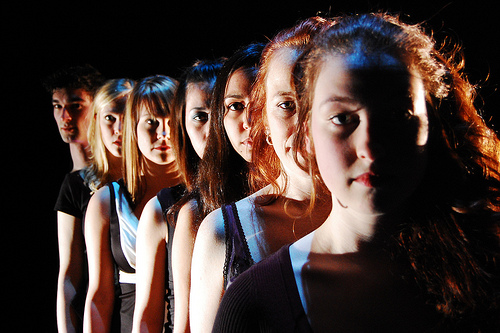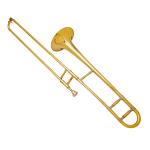
Jackson was inspired to come up with a solution based on an experience he once had at an opera performance in Germany. A principle performer was out sick and the understudy was stuck in an airport in another city. So the opera drafted in the assistant director to perform the character’s moves on stage. Meanwhile, a singer, standing to the side of the stage with the score on a music stand, sang the role. Jackson thought this enhanced his experience of the opera, so he decided to try something similar at SF State.
Bega sat or lay down to the side of the stage throughout the performance on a foam pad. She spoke her assigned lines and used her face and upper body. The production’s assistant director, Allison Combs, performed the rest of Bega’s physical movements on stage.
Besides feeling a twinge of sorrow for Bega, who clearly wanted to be moving around in the middle of the stage with her fellow cast members in this heavily movement-oriented production, I thought the solution worked very well and didn’t detract from the action. Jackson’s conception of the tragedy is very emotional — we watch Juliet’s emotions yo-yo from ecstasy to suicidal depression. The young cast really taps into the teenage spirit of the character. Bega’s presence on stage adds a sobering, anchoring dimension to the highs and lows. She makes us see the solid core at the center of this highly-strung Juliet.
The way in which the rest of the actors interact with Bega is also interesting. There is constant communication between Bega and her fellow cast members. Combs pays special attention to Bega throughout as the physical component of her character. At one point, Combs removes Bega’s boots and shoes for her. Bega leans on Combs when she walks on stage at the start of the show. It’s touching to see the two actresses work together.
And from an institutional perspective, the approach to problem-solving and sense of camaraderie emanating from the stage is a powerful thing to watch. The actors and other production personnel must have learned many lessons about teamwork through this process that can only serve them well in the future.

 I am not a fan of those lists of “Top 50 Women Artists” or “Top 10 Young Conductors” or “The 20 Most Powerful Cultural Movers and Shakers” that pop up with alarming frequency in the media.
I am not a fan of those lists of “Top 50 Women Artists” or “Top 10 Young Conductors” or “The 20 Most Powerful Cultural Movers and Shakers” that pop up with alarming frequency in the media. While cycling down the coast in Kauai last week, I chanced upon an extraordinary sight. I heard the trombones before I saw them, actually. Brass scales and arpeggios caught my ears as I whooshed along, providing an unusual sonic backdrop for the palm trees, sandy beaches and ocean setting.
While cycling down the coast in Kauai last week, I chanced upon an extraordinary sight. I heard the trombones before I saw them, actually. Brass scales and arpeggios caught my ears as I whooshed along, providing an unusual sonic backdrop for the palm trees, sandy beaches and ocean setting. The weather not being all that cooperative in Hawaii last week, I ended up spending quite a bit of time trying to find fun things to do indoors. At the advice of a sweet and avuncular Michigan lawyer names John who was on Kauai vacationing with his wife, I followed a dirt track just outside the center of the town of Hanalei to hear a slack key guitar concert in a local community center given by a couple of Hawaiian old timers
The weather not being all that cooperative in Hawaii last week, I ended up spending quite a bit of time trying to find fun things to do indoors. At the advice of a sweet and avuncular Michigan lawyer names John who was on Kauai vacationing with his wife, I followed a dirt track just outside the center of the town of Hanalei to hear a slack key guitar concert in a local community center given by a couple of Hawaiian old timers